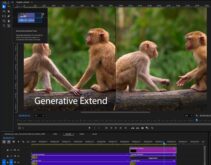
[Author’s note: Video from the session is available below, as is the presentation.]
The two biggest pricing mistakes you can make is to assume that the market has no alternative, and that you don’t have to get it right the first time. HEVC Advance in particular, and the HEVC IP ownership group in general, who still haven’t come together with a comprehensive, all-inclusive royalty offering, made both (and still are). Sometimes when you wake the sleeping bear, it eats you.
I spoke on HEVC at the recent Streaming Media Conference, and spent considerable time addressing how the AV1 codec from the Alliance of Open Media (AOM) will impact HEVC’s success (you can download the handout below). As you may know, the Alliance was founded in September 2015 by Google, Microsoft, Intel, Mozilla, Cisco, Netflix and Amazon. More recently AMD, ARM, and NVIDIA joined the group.
While preparing my presentation, I came upon a quote from David Ronca, who is Director of Encoding Technology at Netflix (on the left). In a recent LinkedIn post in the H.265/HEVC group, he stated.
“The problem is that no one knows what the actual price of HEVC codec will be because the IP holders are fragmented, and many have not yet declared their intentions. The uncertainty of HEVC royalties is exactly why we need AOM.
AOM is testing the hypotheses: 1) Royalty free (RF) codec will remove uncertainty, 2) RF codec can advance the state of the art, 3) RF will remove IP/royalty politics and 4) Benefits of widely adopted RF codec will drive collaboration and innovation.
If AOM is a technical success, and the codec survives legal challenges, then the era of royalty-based codecs will end (as it should).”
Ronca is one of the most respected voices in the encoding world, and Netflix a highly respected leader in premium content distribution. You have to assume that these words will carry a lot of weight.
Let’s take a quick look at how we got here.
Contents
Hindsight is 20:20
Looking back, HEVC Advance in particular, but the HEVC IP ownership community in general, made (at least) one critical mistake in their pricing. They thought they were the only game in town. So MPEG LA came out with a $0.20/unit royalty with a $25 million cap, and HEVC Advance came out with up to $1.20/unit, content royalties, and no cap, and for a five-month period before HEVC Advance came to their senses, some pretty major companies with impressive codec-development chops were wondering if they could do better. So the Alliance for Open Media was born.
Now we’re left to ponder what makes HEVC worth the known $65 million annual cap given the availability of VP9 in the short term and the AOM Video codec (called AV1), scheduled to ship by March 2017, available in the medium term. In most markets, I just don’t see it.
Let’s fast forward to a reasonable prediction of how things will look in January 2018.
– Browsers – Google Chrome, Mozilla Firefox, and Microsoft Edge will all support AV1. None will support HEVC.
– Content – YouTube, Netflix and Amazon will all deploy AV1 to compatible browsers and compatible OTT devices (note that Roku 4 already supports VP9 decode). Netflix and Amazon will still send HEVC to Smart TVs and OTT boxes, but YouTube will distribute UHD video only in VP9 or AV1. Note that I heard at Streaming Media East that Netflix and Amazon are already encoding with VP9, though I couldn’t verify this.
– Hardware – ARM, Intel, AMD, and NVIDIA ensure that low cost hardware with AV1 encode/decode is available for mobile devices, Smart TVs, set top boxes (STB) and OTT boxes like Roku and Apple TV.
This being the case, if you were a product manager creating the specs for a new Smart TV, STB, or OTT box, would you leave out AV1? I sure wouldn’t.
The Questionable Inherent Value of the Standard

In the days of analog TV, standards were essential to ensure compatibility between disparate devices that weren’t upgradeable. Looking at today’s discrete individual markets, you have to wonder exactly what value HEVC brings that makes it worth $65 million for the larger players.
– Browser – Zero here, since HEVC isn’t available, and given all the content that will be produced with AV1 and VP9, you can’t argue you need HEVC to access premium content.
– Mobile – HEVC playback is already in Android and iOS, though Apple is using HEVC only for FaceTime. But exactly what value does it bring that makes it worth $60 million or more to Samsung, Apple, Google, and Microsoft, particularly once AV1 hardware is available? Certainly this market is slower moving than the browser market, since it depends upon hardware-based decode, but why would any company continue to pay $65 million annually if not absolutely essential?
– IPTV – My definition of IPTV is where the vendor specifies the decoder. Essentially this makes IPTV a closed system, and the standard delivers very little value since compatibility can be achieved by selecting the right STB. Note that V-Nova with their proprietary PERSEUS codec has already achieved a major IPTV deployment with Sky in Italy, so it’s hard to say that standards always win in this market.
– Smart TV/OTT – compatibility is a big deal here, and I don’t see HEVC leaving these devices, particularly Smart TVs, for some time. But I see AV1 playback incorporated in these devices in the medium term as well, which erodes the value that HEVC provides. Don’t forget, both Amazon and Google are big players in the OTT market, and they’re AOM charter members, so you have to assume that AV1 playback will be on their devices as soon as possible.
– Ultra HD Blu-Ray – Of course, markets that are directed by a standard, like Ultra HD Blu-Ray, will remain with the standard until that’s changed. However, note that at least one chipset created for Ultra HD Blu-Ray, the MediaTek MT8581, supports HEVC and VC9, as does the Philips BDP7501 Ultra HD Blu-Ray player. The handwriting is on the wall, and clearly I’m not the only one seeing it.
Whither Apple?
I think too much has been made about Apple’s allegiance to HEVC because it’s in the MPEG LA HEVC patent group. There are 32 pages of patents in the MPEG LA group, and Apple holds six, about 1/8th of a single page. While I know nothing about how the MPEG LA HEVC revenue is split, I think it’s reasonably safe to say that Apple will pay far more to HEVC Advance and MPEG LA than they will ever earn back from MPEG LA.
Apple is always a wild card, but at this point you have to ask, why wouldn’t they join AOM and support the AV1 codec? You really can’t argue that HEVC is making their products more competitive, particularly because Apple has removed any mention of HEVC from their spec sheets. Consumers don’t care what’s inside; they just want content, which AV1 should be able to provide.
It’s a Crying Shame

Before and after the conference session, I ran these premises by several encoding professionals. All agreed that the HEVC royalty mess stalled deployments, though some felt the future was brighter for HEVC than expressed here. All of them think HEVC is a great codec, and that it was a shame that a disorganized and overly greedy patent group stalled (at best) the codec’s chances.
The overarching lesson is that pricing is always a bitch. The two biggest mistakes you can make is to assume that the market has no alternative, and that you don’t have to get it right the first time. HEVC Advance in particular, but the HEVC IP ownership group in general, who still haven’t come together with a comprehensive, all-inclusive royalty offering, made both. Sometimes when you wake the sleeping bear, it eats you.
You can download the handout, and watch the video, below.
 Streaming Learning Center Where Streaming Professionals Learn to Excel
Streaming Learning Center Where Streaming Professionals Learn to Excel








